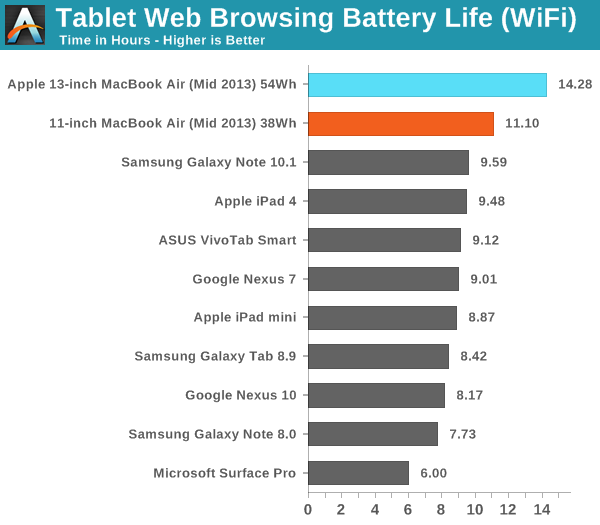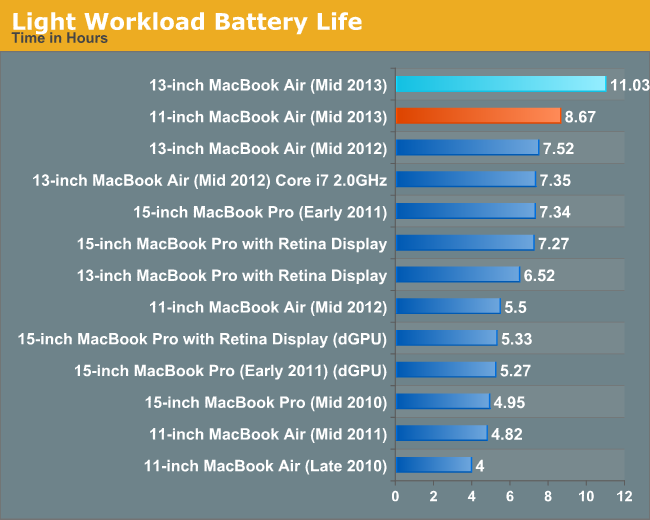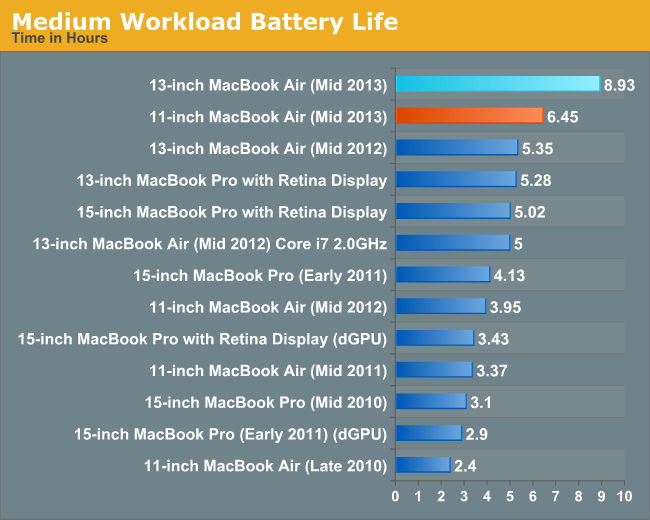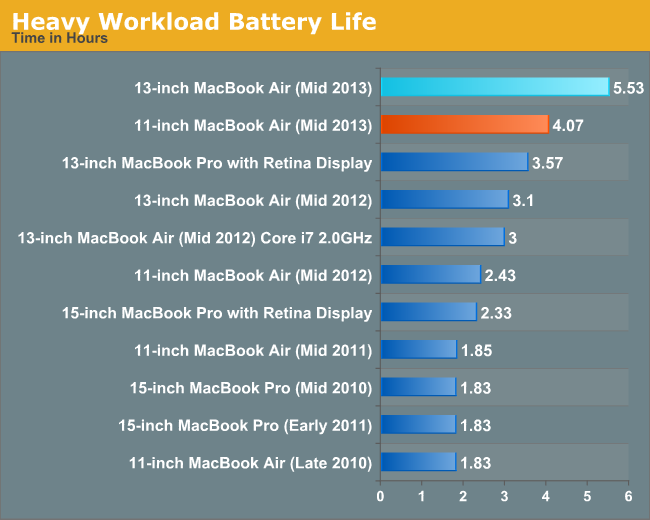The 2013 MacBook Air Review (11-inch)
by Vivek Gowri on August 9, 2013 1:45 AM ESTHonestly, for me, this is by far the most important part of the review. With there being not much in the way of performance upgrades or new features compared to previous generation Airs, the battery life improvement is basically at the heart of what makes the new Air attractive. Obviously, this isn’t exclusive to just Apple—any Haswell ULT Ultrabook with 40-50Wh of battery capacity should get you 8-10 hours of battery life.

But it’s honestly amazing to use a fully fledged notebook that can battle Atom and ARM for battery life. The image from Anand’s 13” Air review showing an estimated 16 hours of battery life was awesome, even if the OS X battery runtime estimate tends to be wildly optimistic in the early part of a battery cycle. The 11” isn’t quite that far, but it still has better battery life than my iPad. Granted, my 3rd-generation iPad now has a year of wear on the battery, but still—it’s longer lasting than my iPad was when new, and it’s also longer lasting than the 4th gen iPad. And not just by a little, it’s a pretty significant step up. That’s a really important corner to turn for the notebook market, double digit battery life without having to resort to an extended or secondary battery like some business notebooks have offered in the past.
As Anand covered in his recent Haswell ULT battery life article, Intel still needs to work on the power efficiency of the Haswell video decode engine, since ARM-based SoCs still hold a sizable advantage there. But other than that caveat, the overall power consumption of Haswell is an absolute game changer. I’ve never even thought to take the power cord with me anywhere in the month that I’ve had it. Want to take the Air for a weekend away and not plug it in once, iPad style? Depending on how much of your usage can get pushed to a smartphone, that’s a legitimate and realistic possibility.
The 11” Air, by virtue of its smaller display, is slightly more efficient than its larger sibling, but the 42% advantage in battery capacity pushes the 13” Air’s battery life into the insane range. Being able to rely on nearly 10 hours of battery life or more in most normal use cases is just ridiculous. The 11” is a bit less phenomenal, but anything that can claim better battery life than the iPad, even with a smaller battery, is doing just fine.



At 8.5 hours dead on in our usual Mac light browsing test, the 2013 11” is three hours ahead of the 2012. That’s 54.5%. It’s nuts, the end. That advantage holds basically through the rest of our more strenuous battery life tests. The previous 11” really had an issue with battery life—the real-world 5 hours of runtime just didn’t cut it given the sacrifices made for mobility; it made much more sense to get a 13”. Now, with 8+ hours of runtime, it’s easier to ignore. The jump from 5.5 to 7.5 hours of battery life makes a pretty significant difference in how the system gets used, but I’m less sure about the difference between 8.5 and 11. Once you’re already in that 8-10 hour battery life range, adding two or three hours on top of that is a lot less valuable than it would be in a situation where you’re adding that amount to get to that range. This isn’t to say that more battery life isn’t always better, just that at some point it becomes something that is nice to have rather than something that changes the essence of the system, almost like the difference between an i5 and an i7 CPU.










139 Comments
View All Comments
teiglin - Friday, August 9, 2013 - link
Minor correction: I believe the Vaio Pro 11 has a 31Wh battery (spec page says 4125mAh, pretty sure it's 7.5V).I hadn't realized the Vaio Pro had come down already--and the Sony website is having a most upgrades discounted--only $120 to go from 128->256GB SSD is especially appealing. If you include the rebate, an 8GB/256GB Vaio Pro 11 is only $1250 compared to $1300 for the same configuration of 11" Air. There is certainly an argument to be made in favor of the Air's body over the flexible carbon fiber Vaio Pro, and the Air certainly has the advantage in battery, touchpad, and GT3; in my opinion, though, a 768p TN panel has no place in a $1000+ device any more.
ananduser - Friday, August 9, 2013 - link
GT3 is not all that it could have been since it's hampered by the 15W TDP of the SKU. HD4400 has proven faster in certain areas when paired with a faster CPU than what the MBA sports. I believe Anand showed this in the original MBA13" review.Glindon - Friday, August 9, 2013 - link
If I recall correctly the CPU turbo boost is the same on 4600 and 5000 models. So unless you are using the graphics at full bore the CPUs should be comparable. I'd rather have better graphics.ananduser - Saturday, August 10, 2013 - link
At low frequencies a 300MHz-500MHz increase is noticeable. Again I point to Anand's review of the faster 13" MBA. Thus the CPUs are not comparable and it is this that allows the the HD5000 to underperform in certain areas compared to HD4400.iwod - Friday, August 9, 2013 - link
I would love to get a bigger screen with the Current 11" MBA. Which is still leaving quite lot of bezel space left and right. The Size of 11" MBA is perfect. But Just that slightly larger display would do. The same goes for 13" where it could actually fit in a 13.9" or 14" LCD instead.Other then that, Anand has already covered there are lot of space left in the MBA circuits which means next generation Broadwell CPU will get that redesign along with even bigger battery. Along with better software and Video Decode. So i think the MBA this year is good. The next one is going to be Great.
DesktopMan - Saturday, August 10, 2013 - link
Totally agree about the bezel. Could probably fit a 12 inch display there.EnzoFX - Saturday, August 10, 2013 - link
Of course it can. Since the current display is 11.6". =p
Daniel Egger - Friday, August 9, 2013 - link
Why would Apple want to radically change a proven chassis design? Just because it looks aged? Sorry but that is bollocks. I would even go so far as to say this is by far the best design in the market and as long as no one (including Apple) can come up with a better package they should stay with this one and make incremental changes, like getting rid of the f...ing bezel around the screen and have a matte gorilla glass screen going edge to edge.GekkePrutser - Friday, August 9, 2013 - link
In my opinion it's not that it looks aged, the only thing that looks out of place is the large bezel (especially on the 11")But the problem is that it no longer pushes the envelope. When Apple released the 2010 model it was the smallest and lightest you could buy for the price (not including much lower-specced netbooks).
Now everyone is doing unibodies and they're all at the same point, most of them are doing it better than Apple (e.g. Samsung with their small bezels and better screens). I think Apple should keep pushing forward, and push the 'ultramobile' thing to the max again. I'd love to see something similar to this: http://www.engadget.com/2013/04/19/inhon-blade-13-... a 870g/1.9lbs 13" laptop..
nerd1 - Friday, August 9, 2013 - link
Huge bezel, terrible resolution (and TN screen), heavier than others (compared to series 9 / vaio pro etc which are almost 25% lighter)